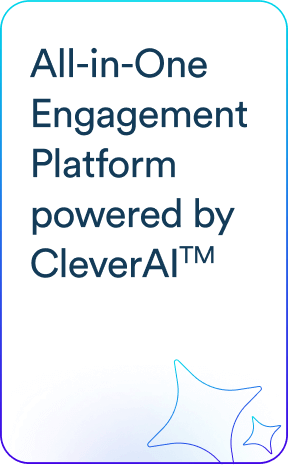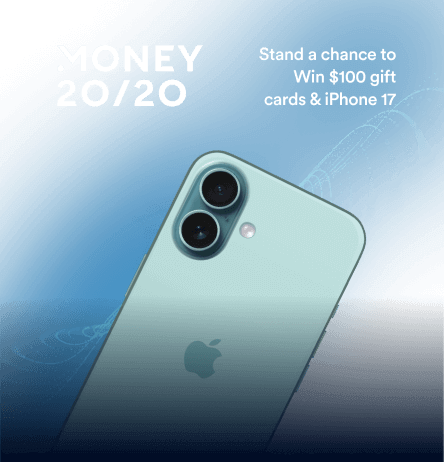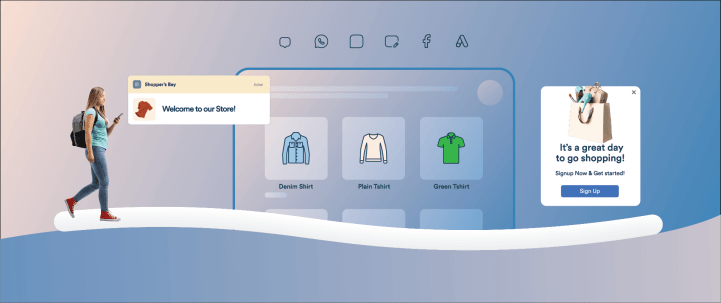In business, there’s no relationship that’s more important than the relationship between your brand and your customers. Everything your company does should ultimately be in support of serving your customers and users well and providing them with an exceptional experience at a reasonable price.
What is a Customer Journey?
A common way to conceptualize a customer’s experience with your company — from their initial discovery of your brand, to their first conversion, to eventual loyalty, and every interaction in between — is the customer journey.
The customer journey is the path a customer takes with your brand and is commonly characterized by five specific stages:
- Awareness
- Acquisition
- Conversion
- Retention
- Loyalty
The touch points in a journey can be visually represented through a customer journey map, which provides a complete picture of the stages a customer goes through.
To grow your mobile app, understanding the customer journey is a critical step as it helps you:
- Predict each customer’s behavior based on the stage they’re in,
- Anticipate their needs, and
- Direct the company’s response.
As well, understanding the different stages of the customer journey is essential for creating effective campaigns that are targeted to the customer based on where they are in their journey with you.
Customer Journey vs. User Journey
In terms of nomenclature, customer journey and user journey are interchangeable terms. The key difference in usage is that “user” is a generic term for any person using your app or service. Whereas “customer” is a term used in industries where the relationship is primarily transactional, i.e. based on users making a purchase. As customer journey is the more common usage, we’ll use that term more frequently throughout.
User Journey vs. User Flow
A common question is what’s the difference between a user journey and a user flow — or are they the same? Answer: They are not. The difference between user journey and user flow is “emotion.”
A user flow is simply the steps that a customer takes to achieve a goal within your app. The term “flows” comes from flow charts, where each action leads to a result. There is no emotion involved.
A user journey, on the other hand, attempts to capture and map out a customer’s feelings, expectations, and questions as they use your app. Here, it’s all about emotions. How does a customer feel as they use your product or interact with your company? Elated? Frustrated? Entertained? In short, a user journey map shows how a customer experiences your brand.
Because every customer has a story, and every interaction between your brand and that customer becomes a part of the story. When you graph these interactions over time, you are essentially creating a map of how your brand appears — and appeals — to your customer.
Benefits of Understanding the Customer Journey
There are significant benefits to having a comprehensive and nuanced understanding of the customer journey. Primarily, your awareness of the customer journey provides insights into your target audience’s needs and expectations. And 80% of companies compete largely on the quality of their customer experience, according to Gartner.*

Other benefits of a clear and thorough understanding of the customer journey include:
- Understanding customer behavior. When you know what actions your customers are taking, you can better understand what drives them. And this allows you to better serve their needs.
- Improving your marketing ROI. While you likely practice omnichannel marketing, not every channel or touchpoint is as effective as others for engaging and converting different customers. But when you analyze the customer journey, you’ll better understand which channels are generating the most sales or conversions. This lets you optimize your resources by focusing on those channels over lower performing ones.
- Identify where customers are dropping off. When a customer fails to complete the journey — in other words, fails to convert — you need to understand what’s happening. There may be a problem with the experience or the product or service you’re offering. When you discern patterns in the customer journey, you’re then able to address any issues to improve outcomes.
- Improve how you target your audience. The better you understand your customers and prospects, the more effective and targeted your marketing will be. A deep understanding of the customer journey will help your marketing team meet customers’ expectations and address their pain points.
- Increase customer engagement: By aligning your marketing efforts with each stage of the customer journey, not only can you create more relevant campaigns, you can improve their overall experience with your brand, which should naturally increase their engagement and their long-term loyalty.
- Improve customer satisfaction: By creating seamless, targeted, and relevant experiences at every stage of the customer journey, you’ll improve customer satisfaction and loyalty by better speaking to their needs at the moment.
- Increase conversions: Knowing that the customer is reaching the decision stage allows you to create marketing messages designed to encourage their conversion, whether that’s becoming a paying customer or some other action that your industry considers a conversion.
At each stage of the customer journey, there are specific things that you can do to improve the customer experience and increase the chances of converting users into loyal customers. This is why understanding each stage of the customer journey is essential for mobile marketers who want to create effective campaigns and improve their bottom line.
The Five Stages of the Customer Journey
Different businesses and different industries define the customer journey and the steps within differently. Some define only five steps, others posit seven or eight. The key is not the variation or finding and using the “one true definition.” The key is simply to understand the different stages, why they’re important, how you should try to optimize for each, and what the whole concept of a customer journey is all about and why you should take the time to understand it.
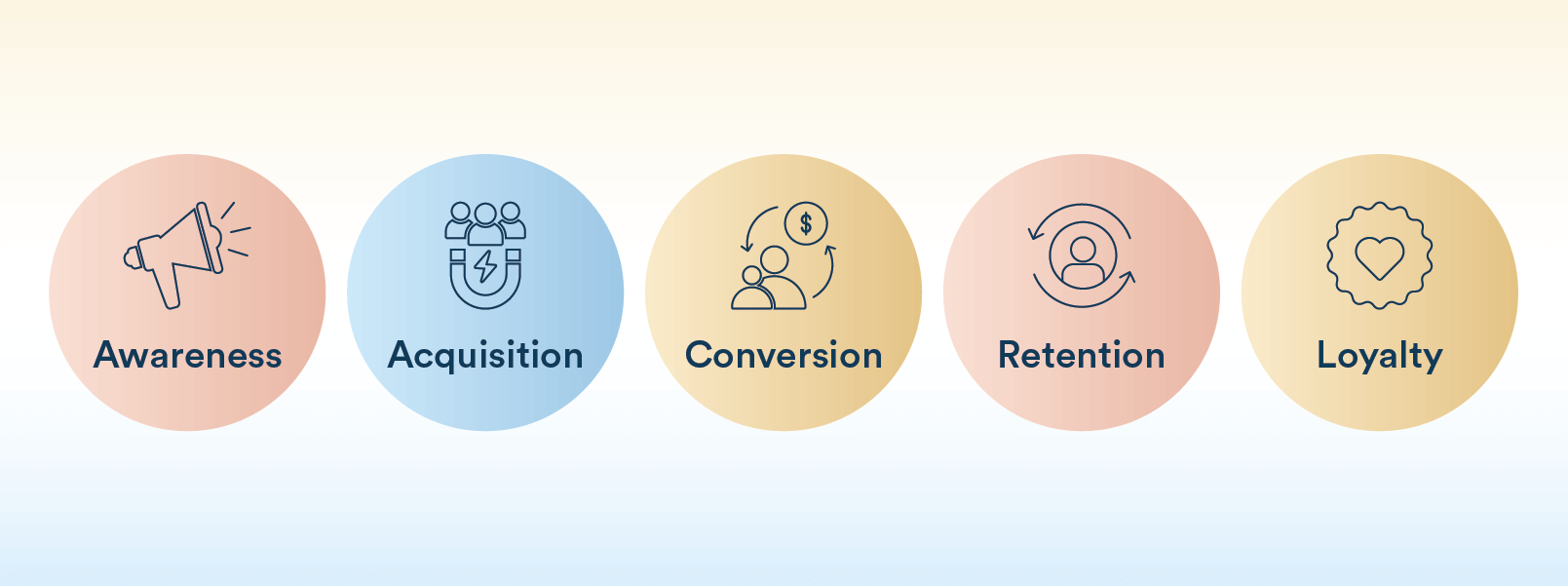
Below, we outline a customer journey made up of five stages. Although the terms used to denote each stage may differ slightly from one company to another, the overall concept is generally the same — starting with awareness and ending with advocacy.
Customer Journey Stage 1: Awareness
Think about it: Your customers can’t use your app and make purchases or otherwise interact with your business if they don’t know you exist. This is why the first stage of the customer journey is discovery or awareness.
As a marketer, your goal at this stage is to capture potential customers’ or users’ attention and drive them to your app (or website). You do this by creating engaging content that highlights the value of your brand and how it is the best choice to meet their needs.
First, you need to know where your target audience is spending their time. This could include social media, search engines, other apps, or app stores. Once you have an understanding of your prospects and the sites they visit or apps they use, target them with campaigns to make them aware of your app. And of course, make sure that everything you do is mobile friendly. For example, your website should be easy to navigate and optimized for mobile devices.
A variety of channels and tactics are available to reach customers at this awareness stage, including:
- Search engine marketing – to target customers who are searching for keywords related to your product or service
- Advertising – mobile, digital, print, etc.
- Social media marketing – generally an extremely effective channel for consumer apps
- Influencer marketing – depending on your brand and budget and identifying appropriate influencers
- Content marketing – creating educational and informational content, more often used in B2B marketing
Of course, using an omnichannel marketing strategy is often the most effective strategy. By using a variety of channels to reach your target audience, you’ll increase the likelihood of potential users discovering your apps and learning more about what you have to offer.
But beyond your choice of channels, understanding your customers and prospects, being thoughtful in your approach, and designing a campaign that will resonate with them is the key to creating awareness for your app and brand.
Best Practices for Awareness
Some best practices here include:
- Use data to target your audience. By collecting data on your target audience, you can identify the channels where they are most active and tailor your campaigns accordingly.
- Create engaging content that highlights the benefits of your app. Your content should be informative, persuasive, and visually appealing.
- Use a variety of creative formats. Your campaigns should include a mix of different creative formats, such as videos, infographics, and social media posts.
- Track your results and make adjustments as needed. Monitor the results of your campaigns so that you can see what’s working and what’s not. This will help you to improve your campaigns over time.
Customer Journey Stage 2: Acquisition
Once you have reached your target audience through your awareness campaigns, your next step is to get them to install your app. This means making it easy for these potential customers or users to both find your app and install it.
Here are some tips for converting mobile visitors into app installs:
- Make it easy for users to find your app in the app store. Use relevant keywords in your app store listing and high-quality screenshots and videos to showcase your app. More tips here: 10 App Store Optimization Tips to Send Your App to the Top of the Charts
- Offer mobile-exclusive incentives. This could include discounts, coupons, or early access to new features.
- Use mobile retargeting to bring visitors back to your app store listing. Show retargeting ads to users who have visited your website or app store listing but have not yet installed your app.
You should also encourage users to create an account. Tell them why this will benefit them, for example, by saving key information, history, and preferences.
The Importance of Registering Users
When a user registers or creates a sign-in to your app, this enables you to collect additional information about them such as their contact information, demographics, and various preferences. This also gives you an opportunity to get their permission to communicate with them.
For example, the team at WinZO knew that the first few days of a new user installing the app were particularly critical. “You have to act right there. Once somebody has decided to give you a chance, you need to listen to what they’re doing on the app, and help guide their journey,” notes Angad Sehdev, the company’s Head of Product. The product team’s agenda, therefore, is to capture data very quickly, get insights on it very quickly, and then to drive experiences using those insights and journeys on the app, with the minimum possible turnaround time.
You can also use push notifications (with their permission) to alert users who have visited your website but haven’t signed up yet about a free trial or limited-time discount. All of this will move them further down your sales and marketing funnel.
Optimize Your Onboarding
Make sure your onboarding process is simple and straightforward. Don’t ask for too much information, and offer social logins to make it easy for users to sign up. Use content-rich in-app messages to welcome and onboard new users, and help them navigate your app.
Indeed, the onboarding process is a crucial step as studies have shown that the majority of app users uninstall within the first three days.
Mobile Premier League (MPL), India’s largest eSports and mobile gaming platform, nudges new users to engage early in free gameplay or entry-fee-based tournaments by explaining the breadth of games available on the platform. Specifically, they encourage new users to choose an MPL Battle—a one-on-one competition where they can win cash prizes—or register for a time-limited MPL Tournament, which awards prize money based on a player’s leaderboard rank. They also use push notifications to increase conversions, using CleverTap to send a campaign for release to their nearly 10 million users within one minute of the campaign being triggered.
Consider Cross-selling
For verticals with large inventories such as ecommerce, online groceries, fashion, and the like, consider cross-selling: acquiring users across different categories or product lines within your business.
Read about how online marketplace Carousell used cross-selling in this blog, which provides an overview of growing a startup through cross-category acquisition.
And to learn more about the effectiveness of different channels, including both paid and organic, check out this blog. We’ve also got a great blog post with examples of all kinds of different — and highly effective — app install ads, for search sites, social networks, banner ads, interstitials, etc.
For more on effective onboarding, download our whitepaper on The Art of Onboarding Mobile App Users.
Customer Journey Stage 3: Conversion
Regardless of whether a user has registered or not, your goal at this stage is to convert them into paying customers or repeat users. This means optimizing your app’s user experience for conversion, however you define it for your app or business. A conversion may be a purchase or it may be something else, such as adding money to an account, signing up for a subscription, or placing their first order.
And of course, if they haven’t registered or signed up yet, you can still encourage them to do so. But don’t make it mandatory. Users still appreciate a “check out as a guest” option.
Conversion Checklist
To support strong conversions, a few things are imperative. You should ensure that your app or brand:
- Provides value and meets their expectations
- Is easy and convenient to use
- Meets all compliance regulations regarding security
- Has a reputation for being trustworthy
- Is responsive to customers’ issues or needs
Then, to encourage conversions, send personalized, relevant, and timely notifications that highlight what your app offers that others do not, something they’ve recently shown interest in, or other compelling offer such as a coupon or discount for new users.
Discover Why One Ecommerce Brand Relies on Multiple Journeys to Increase Retention
For example, a leading UAE ecommerce brand considers personalization, along with marketing automation, an indispensable part of our CRM strategy. And they’ve designed multiple journeys that cover use-cases like cart, wishlist, search and browse abandonment. They’ve also created purchase-intent-based journeys for top-performing categories on the app to bring users back.
Another effective tactic is to take advantage of real-time analytics to track customer behavior and tailor offers that push them towards purchase when they’re active in your app. For example, sending a discount notification at the moment a user adds an item to their cart can motivate them to convert.
More Conversion Strategies
Here are some additional tips for increasing mobile app in-app conversion rates:
- Make it easy for users to find what they are looking for. Use clear and concise navigation and search functionality.
- Highlight your app’s key features and benefits. Use in-app messaging and onboarding to educate users about what your app can do for them.
- Offer targeted discounts and promotions. Use data to segment your users and offer them promotions that are relevant to their interests.
- Make sure your copy is written with the mobile user in mind. This means copy that’s brief and which focuses on user benefits amongst other best practices.
Customer Journey Stage 4: Retention
The most successful brands are those that have built a loyal customer base that keeps coming back for more. Think of brands such as Instagram, TikTok, Alipay, WhatsApp, and Spotify — all examples of brands with a strong track record of retaining customers. And as many studies have shown, returning customers are more likely to buy from a brand they’ve done business with in the past.
In the post-purchase or post-conversion stage of the customer lifecycle, the goal is to engage your existing customers and upsell to them, basically encouraging their continued business and use of your app. Whether it’s an additional purchase, upgrading to a higher-level plan, opting into an additional service, or the use of supplementary features, you have more that you can offer them.
For example:
- Ecommerce apps can send personalized offers to users who have abandoned their carts or haven’t made a purchase after browsing. Encourage them to come back and complete their purchase.
- Streaming apps can highlight the latest shows, movies, music, or podcasts that match their users’ preferences or are trending on your app.
- Fintech apps can share the benefits of some of the other products or services that users haven’t explored yet.
- Social media apps can highlight new features or updates to the app that make it more engaging.
Retention is Omnichannel
Use all the channels that have proven to be effective at engaging customers, and provide regular updates about new features. Push notifications can be a very effective way to re-engage users, along with in-app messages. And in this stage as well, be sure to personalize the user experience as much as possible. After all, these are your users. Show them that you know their history with your app and what they want through personalized messaging to demonstrate to them that you value their continued usage of your app.
In short, your efforts at the retention stage should be toward reducing churn by keeping existing customers engaged, providing them with consistent value, and resolving any issues quickly. Not only will your retention rates increase, you’ll improve your customer lifetime value as well.
How Mindful Mamas Uses Journeys to Drive Engagement
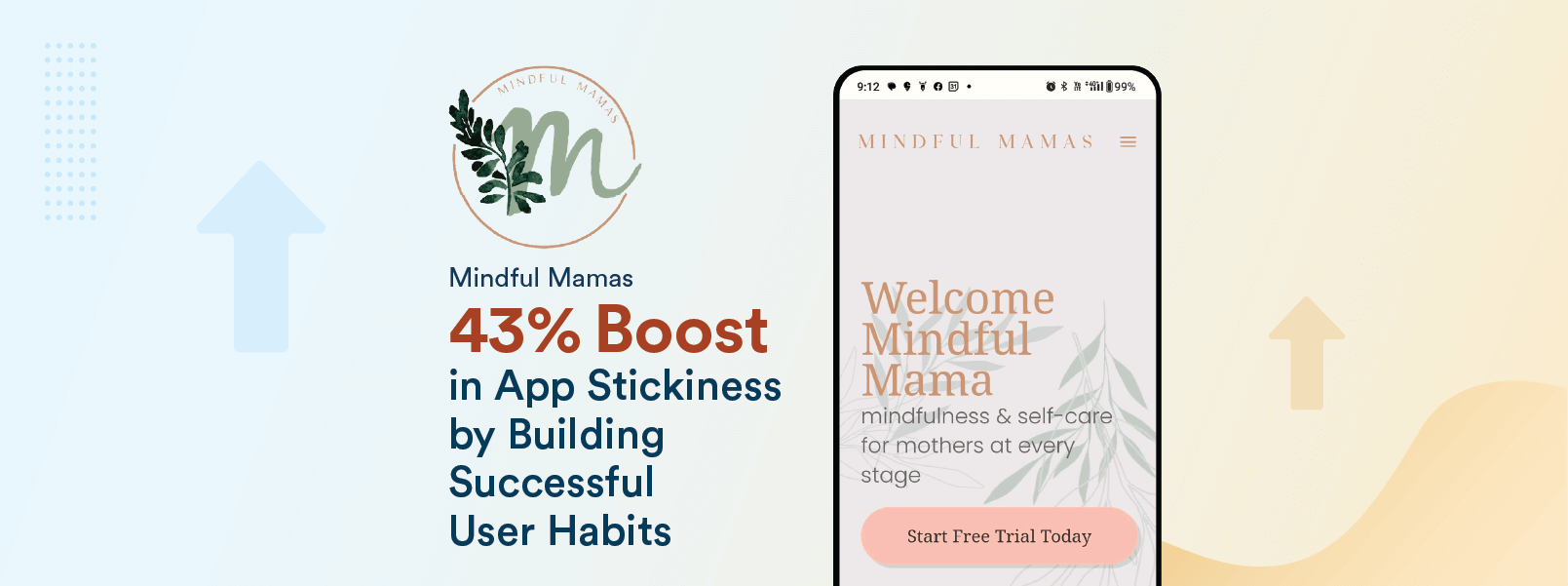
A real-world example is the app Mindful Mamas, which aims to help new mothers along all stages of motherhood through the addition of mindfulness and self-care into their hectic days. The app contains a library of guided meditations, mantras, breathing techniques, and mini-pauses. And because motherhood too is a journey, the app content is organized based on what stage of motherhood or life circumstances the woman is in, so that the app can offer the most relevant, customized support to users.
Effective customer journeys form the nucleus of Mindful Mamas’ user engagement strategy, using them “to exhaustion” mentions Jillian Lee Kobayashi, Co-founder, and COO. They also code custom in-app messages based on custom events and leverage in-app messaging in a myriad of creative ways. And they’ve created campaigns to test user behavior and help the company gain insights to guide their development of upcoming app features.
Customer Journey Stage 5: Loyalty
Customer loyalty is the fifth and final stage of the customer lifecycle. Loyal customers are that segment of customers who have stayed with you the longest, as long-term users or subscribers of your app. Ideally, they’ve also become brand ambassadors, promoting your app and brand to their friends and colleagues.
Reward Their Loyalty
You can encourage customer loyalty by rewarding these users for their business and offering them some kind of benefit or reward for spreading the word. One way to do this is to create a tiered loyalty program that offers different benefits of increasing value to customers at different levels. The goal of these programs is to encourage more buying and referrals from your most loyal customers
For example, a tier-based loyalty program might offer discounts on future purchases, early access to new products, or exclusive events to customers who spend a certain amount of money or make a certain number of purchases. Customers are put into tiers based on their actions, and the loyalty rewards improve as customers achieve higher tiers.
Build Community
In addition to loyalty programs and rewards, another way to encourage customers to stay with you is to build a community for your users, where they can interact with each other in ways that will help them get more out of your app and help others do the same. They might share product feedback, or gaming strategies, or be able to chat with one another on different topics. In short, the more they’re engaged with your brand, the more invested they’ll be for a longer term.
And loyalty can go both ways. Liftoff, a leading performance-based mobile user acquisition and re-engagement company, created a ‘Mobile Heroes’ program to showcase the mobile marketing industry’s brightest players. By investing in their clients’ careers and highlighting their success, Liftoff built a deeper relationship with their customers who appreciated the time and effort the company invested in helping turn their star customers into industry celebrities. In fact, the company found that their clients with a Mobile Heroes commendation are retained three times longer than those without.
Two-Way Communication
And of course, communication is also a two-way street. So any brand that wants to prosper should always provide an easy way for users to share their feedback and experiences, either on your app or website or via a survey sent to their email address.
Get Our User Retention Pocket Guide
Want to dive further into the subject of retention? This highly visual guide provides a high-level overview of user retention fundamentals along with practical tips to win loyal users and grow your app.
Set Yourself Up for Success: How to Analyze Customers Journeys
Now that you have an understanding of each stage of a customer journey, your next step is to start analyzing the entire journey and each stage within, so that you can identify the processes and stages that are working well and those that need to be improved or optimized.
But remember, customer journeys are unique to your product and your customers, so there’s no one-size-fits-all process for analyzing them. However, there are a few common elements to look for:
- Unneeded interactions: Don’t bombard your customers with too many touchpoints. Optimize the customer journey by reducing the number of steps needed to accomplish a task.
- Negative experiences: Identify areas where expectations are not met or where customers have negative experiences with your brand. Prioritize these areas and work to improve them.
- Successes: Just as important are the areas where your app meets or even exceeds expectations. What did you do right? How can you replicate that success in other areas of the customer journey?
- Omnichannel friction: Customer journeys often jump from device to device, so it’s important to identify any areas where shifting to a new channel breaks the journey. For example, an email offer that leads to the brand’s homepage instead of a landing page, or a coupon in a push notification that merely launches the app instead of showing the coupon within the app.
- Time spent at each stage: As customers move from one experience to the next, track how long it takes them to move forward and whether this timing is ideal.
More Tips on Analyzing Your Customer Journeys
Use customer data: Collect data on how customers interact with your product or service. This data can include things like website analytics, customer support tickets, and social media feedback.
Analyze the data: Look for patterns in the data to identify areas where users are struggling or where they are dropping off.
Create customer personas: Create personas to represent different types of customers and their needs. This will help you to understand the different user journeys that your customers take.
Map out the customer journey: Create a visual map of the customer journey, including all of the touchpoints that users interact with. This will help you to identify areas where the journey can be improved. Here’s a free customer journey map template to help you get started. We’ll talk more about customer journey mapping in the next section.
Make improvements: Once you have identified areas for improvement, make changes to your product or service to address those issues.
By analyzing customer journeys, you can identify areas where you can improve the user experience and make it easier for customers to achieve their goals.
How to Create a Customer Journey Map
The customer journey is the route a customer takes to reach their destination — which generally ends at the customer becoming a loyal customer who recommends your brand to their friends and family. A customer journey map then is a visual depiction of that route from the customer’s perspective. It’s a graphic containing visual as text, such as this:
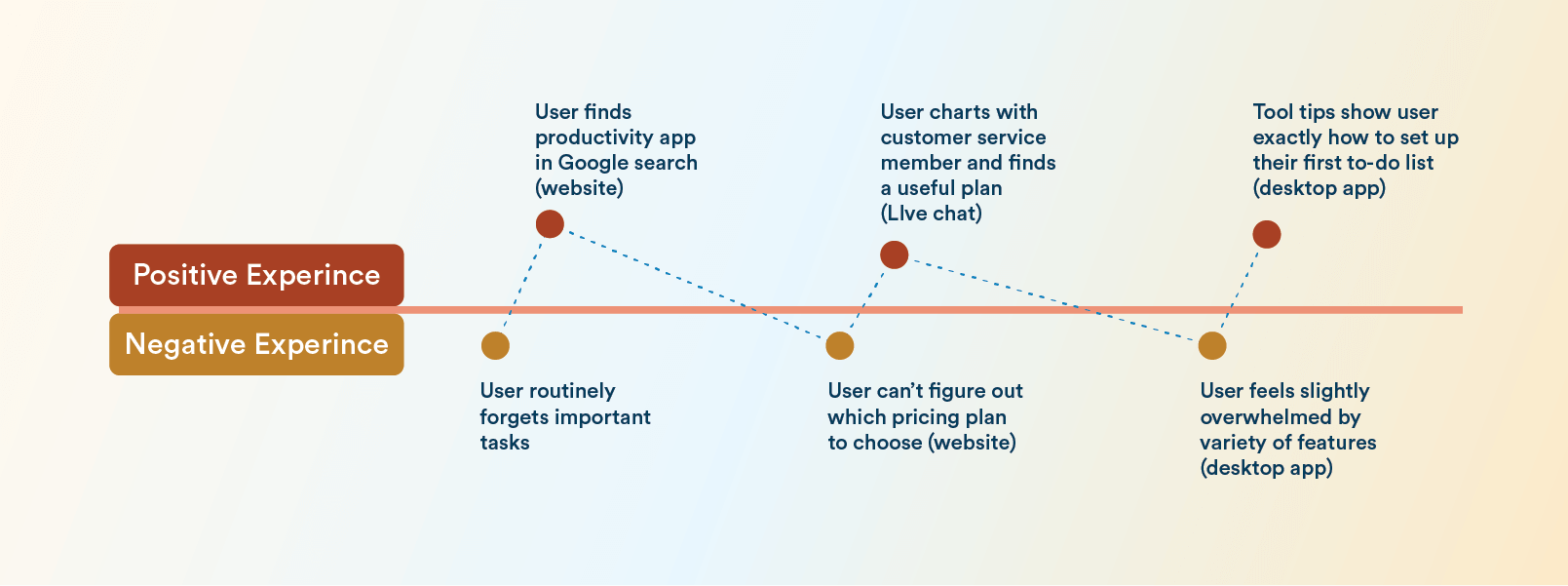
The most important thing to remember is that this map is from the user’s point-of-view. It is not, for example, a product roadmap. Rather, it is a retelling of their interactions with your brand — their user journey from onboarding to conversion and beyond. So, a customer journey map is a graphical representation of these interactions over time.
You might be asking, is there a best time to start building this customer journey map? The answer is yes, there are some guidelines for when to undertake this. First off, you would need to have enough customers so that this set of people constitutes a wide range in terms of demographics and other data variables. What this number is will depend on your industry and the type of app. Nonetheless, you should begin mapping in the early days of your growth, before your user base grows into the thousands and before any viral success happens This is because in mapping the customer journey, you want to:
- Understand every touchpoint where you interact with customers
- Ensure your customers are happy with how they’re experiencing your brand before you get too big
- Uncover opportunities you may not see any other way
Use a Template to Create Your Map
A good template for your customer journey map will include five basic elements: personas, timeline, actions, channels, and feelings/expectations/questions. These elements allow you to define and describe the complete experience a user undergoes.
Again, we note that the focus is NOT your product. Once you view everything from that perspective, building the map becomes much easier.
Personas
This map is about your customers. But which ones? This is where customer personas come into play.
Personas allow you to create general descriptions for certain groups of users. But they also give you enough specific details (e.g. demographics and psychographics) to help you understand their needs and expectations.
Timeline
The second element is a timeline. Remember that this map has a specific duration, with a beginning, middle, and end. The end will be a conversion, purchase, or installation of your app. You map out the interactions that a customer has with you over this duration.
Actions
Actions are simply what a customer is doing at each interaction with your app or brand? Are they watching an onboarding video? Clicking on a push notification? Registering their account? Setting up their preferences?
Feelings, Expectations, and Questions
For every interaction, you need to try to gauge the emotional state the customer is in as they interact with your brand. As seen on the sample map above, the vertical or y-axis of your timeline is split into positive and negative emotional states. The horizontal x-axis depicts time.
Now, what are customers’ feelings, expectations, or questions as they interact with you over time? Are customers perhaps annoyed by too many popups? Or are they happy with a fast download? Use customer feedback as well as your behavioral analytics to note the moods they seem to be experiencing and what prompted this mood or reaction.
You should also look for the events in the customer journey that confuse or anger your users. This will give you a chance to focus on the problem areas. If you can improve these, you’ll positively impact the total user experience for your customers.
Also, don’t forget to figure out what the expectations were during an interaction and what questions might be running through their minds. This extra data will give you a more complete picture of why users behave a certain way.
Channels
Finally, what channel is the customer on when interacting with your brand? Are they watching an onboarding tutorial on a desktop? Are they exiting an in-app notification on their mobile device? Or are they conversing with a salesperson via WhatsApp?
Once you have this user journey charted on a timeline, you’re better able to understand your brand from your customers’ perspective. And with this, you have the ability to empathize with them and better serve their needs and desires.
Wherever there’s a problem area, identify the improvements you can make. Wherever your customers seem to be experiencing frustration, optimize the experience or get rid of stumbling blocks. Do what you can to make things smoother and more streamlined and to make your communications clearer. Engage your customers and do all you can to meet their expectations.
Use Customer Data to Improve the Customer Journey
As in many cases, data provides key answers when you are trying to improve the customer journey and ultimately, the customer experience. By understanding how customers interact with your brand at each stage of the journey, you can create more personalized and relevant experiences.
Here are some ways to use customer data to improve the customer journey:
Segment your customers. Dividing your customers into groups based on their shared characteristics, such as demographics, interests, or purchase history. Customer segmentation helps you target your marketing messages more effectively. For example, you would send a different campaign to customers who have abandoned their shopping carts than you would to customers who have recently made a purchase.
Personalize your content. Customers are more likely to engage with content that is relevant to their individual needs and interests. Use customer data to personalize your website, email campaigns, and social media posts. The more details you can collect on your customers, the more complete your user profiles become, allowing your messaging to be more targeted and effective.
Provide relevant recommendations. Customers don’t just appreciate — they expect brands to make it easy for them to find the products or services they’re looking for. They also expect you to use what you know about them to provide relevant, personalized recommendations when they’re on your website or reading your marketing emails.
Amazon basically built an empire on using data to personalize its website and suggest additional or complementary products, and doing anything less is now considered subpar. And all the streaming services use data to determine what shows to recommend to each user.
For example, Netflix’s use of data and their proprietary algorithm played a critical role in their astounding success.* As a case study, there are certainly few better examples of risk, innovation, and an undeniably effective growth strategy than this streaming giant.
Another example is HBO Max which uses real-time analytics, content curation, and personalization to differentiate themselves and connect and keep their nearly 70 million SVOD customers.*
Reduce friction in the checkout process. One of the biggest pain points for customers is a long and complicated checkout process, which can lead them to abandon their cart, the bane of every marketer’s existence. To mitigate this, use customer data to identify areas where you can streamline the checkout process and make it easier for customers to complete their purchases.
For example, if many customers are abandoning their shopping carts at a certain stage of the checkout process, try implementing a one-page checkout option.
Provide excellent customer service. Customers expect brands to be responsive and helpful when they have questions or problems. And customer data can be used to proactively identify common customer support issues and then develop solutions.
If, for example, you find that many customers are contacting customer support about a particular issue, you could create a FAQ page on your website where customers can easily get answers or develop a knowledge base for customer support representatives to more easily find answers to common problems.
At the end of the day, when you proactively use customer data to improve the customer journey, your customers are more likely to become loyal and engaged.
How to Measure the Success of Your Customer Journey
To understand the impact of your customer journey and how well you’ve designed, personalized, and optimized it, you need to measure it.
To measure the success of your customer journey, you first need to identify the key metrics that are important to your business. These metrics will vary depending on your industry and business goals, but some common metrics include:
- Conversion rates: This metric measures the percentage of visitors to your website or landing pages who take a desired action, such as signing up for your email list or making a purchase.
- Customer lifetime value (CLV): This metric measures the total revenue that a customer is expected to generate over the course of their relationship with your business.
- Customer satisfaction: This metric measures how satisfied your customers are with your products or services and your overall customer experience.
- Churn rate: This metric measures the percentage of customers who stop doing business with you over a given period of time.
Once you’ve identified the key metrics for your business, you can start to track them over time to see how your customer journey is performing. A variety of tools are available to help you track your customer journey metrics. These include Google Analytics, customer relationship management (CRM) software, and customer survey tools.
Helpful Guidelines for Measuring the Success of Your Customer Journey
Set realistic goals. Don’t expect to see overnight results when you start measuring the success of your customer journey. It takes time to make meaningful improvements, and patience here is a virtue.
Track the right metrics. Make sure you are tracking the metrics that are most important to your business.
Be consistent. Track your customer journey metrics on a regular basis so that you can identify trends and areas for improvement and make changes before a trend becomes a serious problem.
Compare your results to benchmarks. Compare your customer journey metrics to benchmarks for your industry. This can help you to see how you are performing relative to your competitors.
An Example: Measuring the Success of Your Customer Journey
Let’s say that you are an ecommerce business and your goal is to increase sales. You could start by tracking the following metrics:
- Website traffic: A measurement of the number of visitors to your website.
- Conversion rate: The percentage of visitors to your website who make a purchase.
- Average order value: This is the amount of money that customers spend when they purchase from your website, on average.
After tracking these metrics for a period of time, use them to start identifying areas for improvement. For example, if you have a high website traffic but a low conversion rate, you may need to improve your website design or marketing campaigns.
You should also compare your customer journey metrics to benchmarks for other ecommerce businesses. This can help you to see how you are performing relative to your competitors.
But be aware that benchmarks vary wildly, so you’ll want to take regular snapshots to compare results with either your past results or other companies in your industry. For example, if your customer acquisition cost (CAC) in the fintech sector is $125, is that considered good? One helpful gauge would be industry-wide benchmarks to compare this stat to the average CAC. CleverTap has a number of vertical-specific app engagement benchmark reports to help you do this.
By measuring the success of your customer journey, you can identify areas for improvement and make changes that will lead to a better customer experience and increased sales.
How to Use Marketing Automation to Nurture Leads Through the Customer Journey
Marketing automation uses software to automate repetitive marketing tasks. This can include tasks such as sending emails, scheduling social media posts, and tracking customer interactions.
Marketing automation can also be used to nurture leads through the customer journey by providing them with relevant content and offers at each stage of the journey. This can help to increase customer interactions, improve customer engagement metrics and drive conversion rates.
Ways to Use Marketing Automation to Nurture Leads Through the Customer Journey
Create lead nurturing workflows. Lead nurturing workflows are automated sequences of emails or other marketing messages that are sent to leads based on their actions. For example, you could create a lead nurturing workflow for leads who have downloaded a white paper from your website. This workflow could send the leads an email nurture drip over the next few weeks with additional information about your products or services.
Use lead scoring to prioritize your efforts. Lead scoring is a process of assigning points to leads based on their engagement and qualifications. This can help identify the leads who are most likely to convert into customers. You can then use marketing automation to prioritize your efforts and focus on nurturing the leads with the highest scores.
Personalize your marketing messages. Customers are more likely to engage with marketing messages that are relevant to their individual needs and interests. You can use marketing automation to personalize your marketing messages by segmenting your leads and sending them targeted content and offers. For example, you could send different email campaigns to leads who are interested in different products or services.
Automate your follow-up. It’s important to follow up with leads promptly, but it can be difficult to do this manually. Marketing automation can help you to automate your follow-up by sending emails or other marketing messages to leads based on their actions or behaviors. For example, you could send an email to a lead who has abandoned their shopping cart reminding them to complete their purchase.
By using marketing automation to nurture leads through the customer journey, you can increase customer engagement and conversion rates. This can lead to more sales and revenue for your business.
Creating Effective Journeys with CleverTap
In this comprehensive guide, we’ve walked you through what a customer journey is and why journeys and journey maps are important. We also delved into each of the five stages that typically comprise a journey, and what kinds of tactics you should employ at each stage to move customers through each stage and ultimately gain their loyalty.
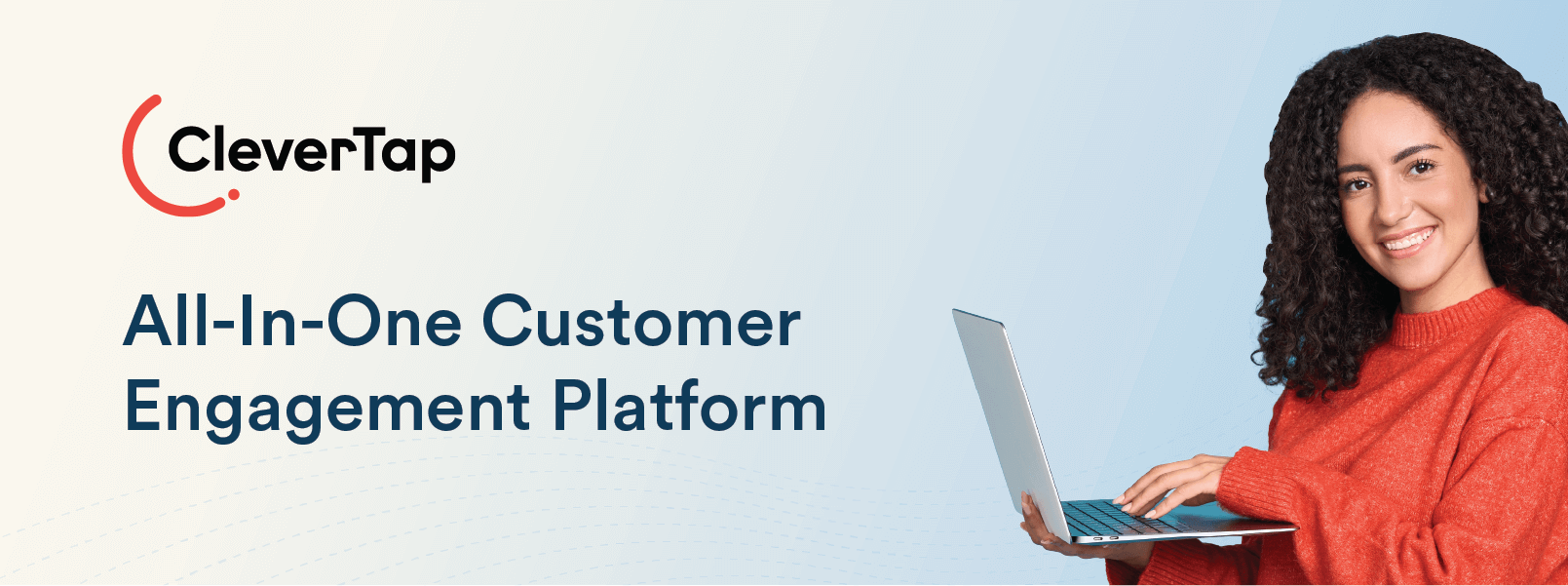
If you’re looking for a platform to support your customer engagement and retention, you’re already in the right place. CleverTap offers a powerful, all-in-one engagement platform, which is automated, scalable, and secure, with all the features you need to create user journeys, and so much more. CleverTap helps companies understand, segment, and engage users in real-time using context and powerful artificial intelligence and machine learning models.
Apoorv Bhatnagar 
Apoorv, Sr. Digital Marketing Manager at CleverTap, drives digital marketing strategies. Expert in SEO, analytics, and channel marketing. Previous roles at Freshworks, excelling in organic SEO, lead generation, and CMS activities.
Free Customer Engagement Guides
Join our newsletter for actionable tips and proven strategies to grow your business and engage your customers.

